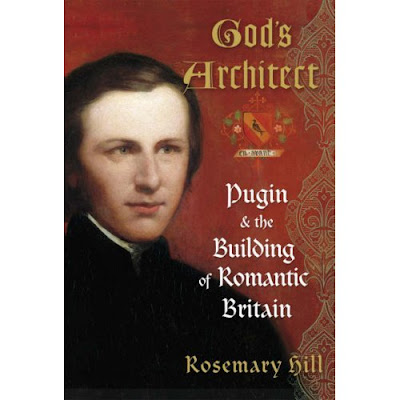
God’s Architect: Pugin and the Building of Romantic Britain
By Rosemary Hill
(Allen Lane/Penguin 2007; available in the US 2008)
We can only applaud the arrival of this lavish biography of a man so deeply involved in the “restoration of Christian culture” in his time. Architect, writer, designer of everything from wallpaper to jewelry to ecclesiastical vestments, Pugin exhibited an energy and scope of activity that to us appears nearly miraculous. As the dust jacket so rightly says: “By the age of twenty one he had been shipwrecked, bankrupted and widowed…before he was thirty he had designed twenty-two churches, three cathedrals, half a dozen houses and a Cistercian monastery.” And by his death at forty, he was the co- creator of the iconic building of 19th century Britain: the Place of Westminster.
Yet, outside of the continuing praise of specialists, who acknowledged Pugin’s central role in launching the Gothic revival and even in foreseeing certain of the more positive aspects of modernity, he had generally faded into the historical background. Of course, he had committed the unpardonable sin (then and now) of being not just a Catholic, but a militant, public one. His own Church too later followed voices and theories Pugin would have despised. All too often Pugin’s sanctuaries, reredoses and altars were smashed or sold after 1965. Even the tabernacle of the church he built next to his own home is now in the Anglican Cathedral of Southwark! (http://www.pugin.com/pugchur.htm )
Rosemary Hill attempts to revise this picture and to put before the reader the entire accomplishment of Pugin. Her biography is well researched, readable and splendidly illustrated. True, we may not be able to follow her unconvincing arguments for an alleged “dark side” of Pugin’s personal life. But these kinds of conjectures are a staple of modern biography.
A more fundamental issue for me is that the author seems to localize Pugin all too radically in his time and place. As presented in this book, he tends to become something like an eccentric character out of Dickens – certainly a highly interesting person but of no further significance to us today. For example, we repeatedly read of Pugin’s raving, of his “hypomanic” state, of how his undiplomatic polemics ruffled the feathers of the powers that be in both the Establishment and in the Catholic Church again and again. One gets the sense that the author of this biography is a not a little uncomfortable with one who would bluntly argue the Catholic cause in public.
Pugin certainly forcefully presented his views both in word and print. Yet he was above all a man of deep principle: not a polemicist for the sake of fighting. His case against the modern order as it had developed in early Victorian England was objective and grounded in theoretical insights that arose out of his work as an artist, not out of reflection over books. In his groundbreaking treatise Contrasts, Pugin does not speculate on the totalitarian threat to mankind latent in the enlightenment, but sets before us contrasting images of a richly articulated medieval hospital and a forbidding modern circular prison. In instances like this, Pugin shows an awareness of the interrelationship among aesthetics, theology, economy and society that is still news today.
To mention another example, Pugin clashed with the leadership of the Catholic Church of his day on the issue of erecting Rood screens between the nave and the sanctuary. He publicly disputed the need of the people to see everything as a non-liturgical abuse. This put him at odds with, among others, Newman and the Oratorians, whose advocacy of 16th century Roman styles allows for no such feature. Today, Pugin’s positions seem insightful and even prescient after we have experienced the effects of the post-counciliar opening up and virtual abolition of the sanctuary, and have become familiar with the contrary witness of the Russian Orthodox Church (the iconostasis).
But allowing for these criticisms, I do think Rosemary Hill’s biography of Pugin may be a revelation for the post-conciliar Catholic feeling his way back to Tradition. Having heard of the pre-1962 “ghetto,” he will be surprised to find a Roman Catholic at the center of the religious and secular artistic life of the most powerful nation on earth. In the Church of the past, supposedly dominated by the clergy, he encounters a layman who fearlessly castigates the artistic and liturgical sins of his own hierarchy. Instead of the inarticulate and apologetic weaklings who speak for the Church today, he meets a man who argues for his faith clearly and unmistakably in words, pictures and works of art.
Really, there is so much material here for the liturgically inclined! One reads of Bishop Wiseman and others celebrating the Mass in the Sarum use in the 1840’s – when did this option disappear? The conflict between the Oratorians and Pugin over Gothic and Roman styles is highly instructive for those who would revive Christian architecture today. But let me stop here and recommend that the reader seek out further details for himself in this fine book.
Related Articles
No user responded in this post